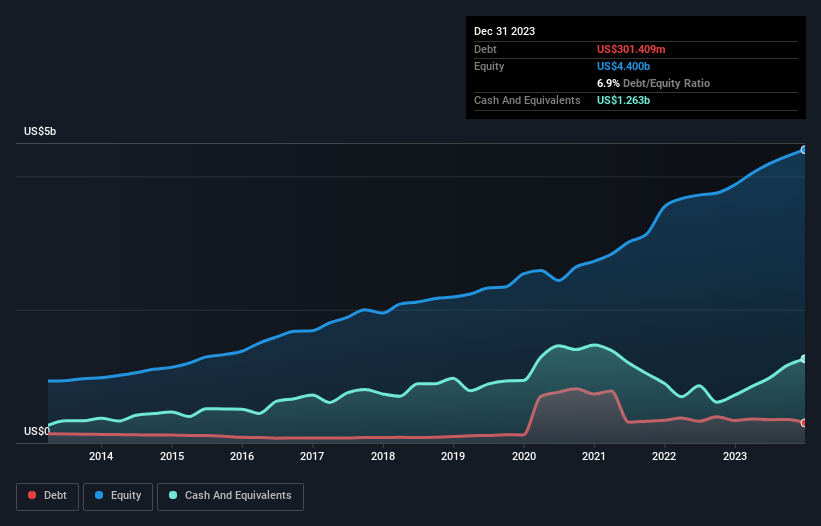
Warren Buffett famously said, 'Volatility is far from synonymous with risk.' When we think about how risky a company is, we always like to look at its use of debt, since debt overload can lead to ruin. We can see that Skechers U.S.A., Inc. (NYSE:SKX) does use debt in its business. But is this debt a concern to shareholders?
When Is Debt Dangerous?
Debt assists a business until the business has trouble paying it off, either with new capital or with free cash flow. Ultimately, if the company can't fulfill its legal obligations to repay debt, shareholders could walk away with nothing. However, a more common (but still painful) scenario is that it has to raise new equity capital at a low price, thus permanently diluting shareholders. Of course, plenty of companies use debt to fund growth, without any negative consequences. When we examine debt levels, we first consider both cash and debt levels, together.
See our latest analysis for Skechers U.S.A
What Is Skechers U.S.A's Debt?
You can click the graphic below for the historical numbers, but it shows that Skechers U.S.A had US$301.4m of debt in December 2023, down from US$339.3m, one year before. But it also has US$1.26b in cash to offset that, meaning it has US$961.1m net cash.

How Strong Is Skechers U.S.A's Balance Sheet?
We can see from the most recent balance sheet that Skechers U.S.A had liabilities of US$1.66b falling due within a year, and liabilities of US$1.49b due beyond that. On the other hand, it had cash of US$1.26b and US$942.6m worth of receivables due within a year. So its liabilities total US$942.3m more than the combination of its cash and short-term receivables.
Of course, Skechers U.S.A has a market capitalization of US$8.78b, so these liabilities are probably manageable. But there are sufficient liabilities that we would certainly recommend shareholders continue to monitor the balance sheet, going forward. While it does have liabilities worth noting, Skechers U.S.A also has more cash than debt, so we're pretty confident it can manage its debt safely.
In addition to that, we're happy to report that Skechers U.S.A has boosted its EBIT by 44%, thus reducing the spectre of future debt repayments. The balance sheet is clearly the area to focus on when you are analysing debt. But ultimately the future profitability of the business will decide if Skechers U.S.A can strengthen its balance sheet over time. So if you're focused on the future you can check out this free report showing analyst profit forecasts.
Finally, while the tax-man may adore accounting profits, lenders only accept cold hard cash. Skechers U.S.A may have net cash on the balance sheet, but it is still interesting to look at how well the business converts its earnings before interest and tax (EBIT) to free cash flow, because that will influence both its need for, and its capacity to manage debt. In the last three years, Skechers U.S.A's free cash flow amounted to 34% of its EBIT, less than we'd expect. That weak cash conversion makes it more difficult to handle indebtedness.
Summing Up
While Skechers U.S.A does have more liabilities than liquid assets, it also has net cash of US$961.1m. And we liked the look of last year's 44% year-on-year EBIT growth. So is Skechers U.S.A's debt a risk? It doesn't seem so to us. There's no doubt that we learn most about debt from the balance sheet. However, not all investment risk resides within the balance sheet - far from it. We've identified 1 warning sign with Skechers U.S.A , and understanding them should be part of your investment process.
At the end of the day, it's often better to focus on companies that are free from net debt. You can access our special list of such companies (all with a track record of profit growth). It's free.
New: Manage All Your Stock Portfolios in One Place
We've created the ultimate portfolio companion for stock investors, and it's free.
• Connect an unlimited number of Portfolios and see your total in one currency
• Be alerted to new Warning Signs or Risks via email or mobile
• Track the Fair Value of your stocks
Have feedback on this article? Concerned about the content? Get in touch with us directly. Alternatively, email editorial-team (at) simplywallst.com.
This article by Simply Wall St is general in nature. We provide commentary based on historical data and analyst forecasts only using an unbiased methodology and our articles are not intended to be financial advice. It does not constitute a recommendation to buy or sell any stock, and does not take account of your objectives, or your financial situation. We aim to bring you long-term focused analysis driven by fundamental data. Note that our analysis may not factor in the latest price-sensitive company announcements or qualitative material. Simply Wall St has no position in any stocks mentioned.
About NYSE:SKX
Skechers U.S.A
Designs, develops, markets, and distributes footwear for men, women, and children worldwide.
Undervalued with adequate balance sheet.

